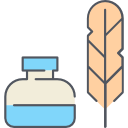
Text
Kelimpahan Dan Keanekaragaman Plankton Sebagai Biondikator Kualitas Air di Perairan Pantai Sayung, Kabupaten Demak, Jawa Tengah
ABSTRAK
Wilayah pantai Sayung merupakan wilayah pesisir dengan aktifitas
pemukiman, pertambakan, kawasan industri yang semakin padat. Hal tersebut
menghasilkan limbah yang secara langsung maupun tidak langsung berpotensi
mencemari lingkungan. Plankton merupakan komponen biologi yang di
manfaatkan untuk mengetahui perubahan kualitas perairan yang terkena dampak
dari kondisi tersebut. Penelitian ini bertujuan untuk mengetahui kualitas perairan
di wilayah Pantai Sayung dilihat dari kelimpahan keanekaragaman plankton,
parameter fisika-kimia perairan serta status saprobitas perairan. Pengambilan
sampel pada bulan Juli 2017 dan April 2018, di perairan Pantai Sayung, Demak.
Pengambilan sampel plankton dan air dari 5 lokasi pengambilan sampel dianggap
mempresentasikan keragaman plankton dan kestabilan perairan. Plankton di
sampling menggunakan plankton net No.25, kemudian diawetkan menggunakan
alkohol 70% + formalin 4%. Data abiotik berupa analisis kandungan nitrat, suhu,
pH, salinitas, DO dan turbiditas. Analisis data dihitung menggunakan indeks
keanekaragaman Shannon Wiener (H’), indeks keseragaman (e), indeks
dominansi (C), indeks saprobik. Hasil analisis plankton ditemukan 49 jenis, yaitu
38 fitoplankton dan 11 zooplankton. Kelompok yang paling tinggi adalah
Bacillariophyta yaitu 14,21%. Nilai Indeks H’ (1,58 – 2,45); maka perairan Pantai
Sayung masuk dalam kategori cukup stabil. Nilai Indeks e berkisar antara 0,64 –
1; nilai Indeks C berkisar antara 0,08 – 0,22; dan nilai indeks saprobitas berada
pada fase β-Meso/Polisaprobik sampai α-Mesosaprobik dengan derajat
pencemaran sangat ringan sampai agak tinggi. Hasil analisis parameter fisika
kimia perairan Pantai Sayung secara keseluruhan masih layak untuk mendukung
kehidupan plankton.
Kata kunci : Kualitas air, plankton, bioindikator, Pantai Sayungv
ABSTRACT
Sayung coast is a area with a growing residential, sea ranching, and
industrial area. Those aspects produce create waste that could harm the
environment, directly or indirectly. Plankton is a biologic component that is used
to indicate the changes of water quality in waters that has been polluted. These
goals of this research are to know the water quality in Sayung coast area from the
abundance of the plankton, physical-chemical parameter of the water, and also
the status of water saprobity. The samples are taken in July 2017 and April 2018,
in Sayung coast waters, Demak. Plankton sampling and water from 5 sampling
stasions are considered to represent the diversity of the plankton and water
stability. Plankton is sampled using plankton net No.25, then preserved using 70%
alcohol + 4% formaldehyde. The abiotic data measureted is nitrate content,
temperature, pH, salinity, DO, and turbidity. Data analysis are done using
Shannon Weiner’s diversity index (H’), diversty index (e), domination index (C),
saprobic index. The result shows that there are 49 species of planktons are found,
which are 38 fitoplankton, and 11 zooplankton. The highest group is
Bacillariophyta which is 14,24%. The diversty index value of H’ 1,58 – 2,45;
therefore the Sayung coast waters is catagorized as stable. The index value of e
ranges from 0,64 – 1; index C values ranges from 0,08 – 0,22; and the saprobirity
index value is in β-Meso/Polisaprobik to α-Mesosaprobik phase with a very light
to very high pollution levels. The physical-chemical parameter analysis of Sayung
coast waters in overall is still suitable to support plankton’s life.
Keywords : Water quality, plankton, bioindicator, Sayung Coast
Ketersediaan
| 1279B19I | 1279 B 19-i | Perpustakaan FSM Undip (Referensi) | Tersedia |
Informasi Detail
- Judul Seri
-
BIOLOGI
- No. Panggil
-
1279 B 19-i
- Penerbit
- : ., 2019
- Deskripsi Fisik
-
-
- Bahasa
-
Indonesia
- ISBN/ISSN
-
-
- Klasifikasi
-
005.118
- Tipe Isi
-
-
- Tipe Media
-
-
- Tipe Pembawa
-
-
- Edisi
-
-
- Subjek
-
-
- Info Detail Spesifik
-
-
- Pernyataan Tanggungjawab
-
Isnaini Nurul Maya Evita
Versi lain/terkait
Tidak tersedia versi lain
Lampiran Berkas
Komentar
Anda harus masuk sebelum memberikan komentar
 Karya Umum
Karya Umum  Filsafat
Filsafat  Agama
Agama  Ilmu-ilmu Sosial
Ilmu-ilmu Sosial  Bahasa
Bahasa  Ilmu-ilmu Murni
Ilmu-ilmu Murni  Ilmu-ilmu Terapan
Ilmu-ilmu Terapan  Kesenian, Hiburan, dan Olahraga
Kesenian, Hiburan, dan Olahraga  Kesusastraan
Kesusastraan  Geografi dan Sejarah
Geografi dan Sejarah